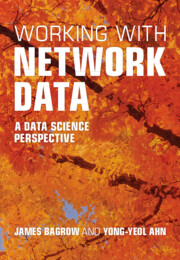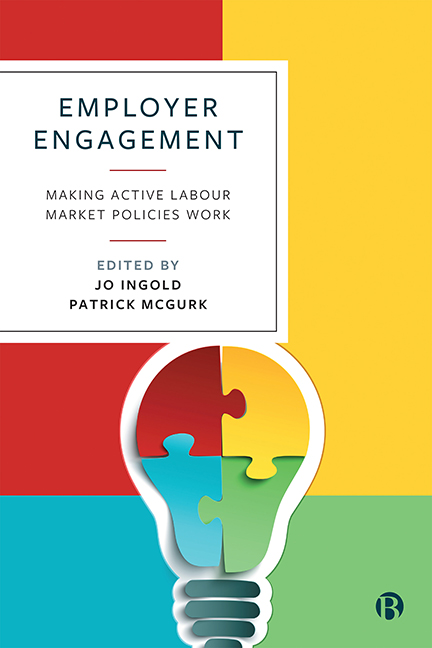Refine search
Actions for selected content:
1835 results in Knowledge Management, Databases and Data Mining
Chapter 17 - Research record-keeping
- from Interlude — Good practices for scientific computing
-
- Book:
- Working with Network Data
- Published online:
- 06 June 2024
- Print publication:
- 13 June 2024, pp 283-288
-
- Chapter
- Export citation
Part II - Applications, tools, and tasks
-
- Book:
- Working with Network Data
- Published online:
- 06 June 2024
- Print publication:
- 13 June 2024, pp 63-64
-
- Chapter
- Export citation

Working with Network Data
- A Data Science Perspective
-
- Published online:
- 06 June 2024
- Print publication:
- 13 June 2024

Employer Engagement
- Making Active Labour Market Policies Work
-
- Published by:
- Bristol University Press
- Published online:
- 18 January 2024
- Print publication:
- 28 February 2023
10 - Conflict and Industrial Action
-
-
- Book:
- The Value of Industrial Relations
- Published by:
- Bristol University Press
- Published online:
- 07 January 2025
- Print publication:
- 15 January 2024, pp 114-123
-
- Chapter
- Export citation
9 - Industrial Relations and Labour Law: Recovery of a Shared Tradition?
-
-
- Book:
- The Value of Industrial Relations
- Published by:
- Bristol University Press
- Published online:
- 07 January 2025
- Print publication:
- 15 January 2024, pp 103-113
-
- Chapter
- Export citation
Contents
-
- Book:
- The Value of Industrial Relations
- Published by:
- Bristol University Press
- Published online:
- 07 January 2025
- Print publication:
- 15 January 2024, pp v-v
-
- Chapter
- Export citation
2 - Frames of Reference in Industrial Relations
-
-
- Book:
- The Value of Industrial Relations
- Published by:
- Bristol University Press
- Published online:
- 07 January 2025
- Print publication:
- 15 January 2024, pp 12-25
-
- Chapter
- Export citation
8 - Labour Markets
-
-
- Book:
- The Value of Industrial Relations
- Published by:
- Bristol University Press
- Published online:
- 07 January 2025
- Print publication:
- 15 January 2024, pp 89-102
-
- Chapter
- Export citation
6 - Expanding the Boundaries of Industrial Relations as a Field of Study: The Role of ‘New Actors’
-
-
- Book:
- The Value of Industrial Relations
- Published by:
- Bristol University Press
- Published online:
- 07 January 2025
- Print publication:
- 15 January 2024, pp 65-75
-
- Chapter
- Export citation
11 - Exploring ‘New’ Forms of Work Organization: The Case of Parcel Delivery in the UK
-
-
- Book:
- The Value of Industrial Relations
- Published by:
- Bristol University Press
- Published online:
- 07 January 2025
- Print publication:
- 15 January 2024, pp 124-136
-
- Chapter
- Export citation
3 - Capitalist Crises and Industrial Relations Theorizing
-
-
- Book:
- The Value of Industrial Relations
- Published by:
- Bristol University Press
- Published online:
- 07 January 2025
- Print publication:
- 15 January 2024, pp 26-36
-
- Chapter
- Export citation
Series Editors’ Preface
-
- Book:
- The Value of Industrial Relations
- Published by:
- Bristol University Press
- Published online:
- 07 January 2025
- Print publication:
- 15 January 2024, pp vi-vii
-
- Chapter
- Export citation
7 - The State and Industrial Relations: Debates, Concerns and Contradictions in the Forging of Regulatory Change in the UK
-
-
- Book:
- The Value of Industrial Relations
- Published by:
- Bristol University Press
- Published online:
- 07 January 2025
- Print publication:
- 15 January 2024, pp 76-88
-
- Chapter
- Export citation
4 - Embedded Bedfellows: Industrial Relations and (Analytical) Human Resource Management
-
-
- Book:
- The Value of Industrial Relations
- Published by:
- Bristol University Press
- Published online:
- 07 January 2025
- Print publication:
- 15 January 2024, pp 37-52
-
- Chapter
- Export citation
12 - Intersectionality and Industrial Relations
-
-
- Book:
- The Value of Industrial Relations
- Published by:
- Bristol University Press
- Published online:
- 07 January 2025
- Print publication:
- 15 January 2024, pp 137-150
-
- Chapter
- Export citation
Index
-
- Book:
- The Value of Industrial Relations
- Published by:
- Bristol University Press
- Published online:
- 07 January 2025
- Print publication:
- 15 January 2024, pp 151-158
-
- Chapter
- Export citation
Notes on Contributors
-
- Book:
- The Value of Industrial Relations
- Published by:
- Bristol University Press
- Published online:
- 07 January 2025
- Print publication:
- 15 January 2024, pp viii-x
-
- Chapter
- Export citation
Frontmatter
-
- Book:
- The Value of Industrial Relations
- Published by:
- Bristol University Press
- Published online:
- 07 January 2025
- Print publication:
- 15 January 2024, pp i-iv
-
- Chapter
- Export citation
1 - Introduction: The Enduring ‘Point’ and Value of Industrial Relations Research
-
-
- Book:
- The Value of Industrial Relations
- Published by:
- Bristol University Press
- Published online:
- 07 January 2025
- Print publication:
- 15 January 2024, pp 1-11
-
- Chapter
- Export citation
